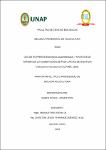| dc.contributor.advisor | Ríos Isern, Enrique | |
| dc.contributor.advisor | Fernández Méndez, Christian Jesús | |
| dc.contributor.author | Gómez Ríos, Karen Gissell | |
| dc.date.accessioned | 2023-12-12T18:02:07Z | |
| dc.date.available | 2023-12-12T18:02:07Z | |
| dc.date.issued | 2023 | |
| dc.identifier.other | 639.3 G68 2023 | |
| dc.identifier.uri | https://hdl.handle.net/20.500.12737/9597 | |
| dc.description.abstract | In fish farming the critical stage is the post-larval stage and is influenced by the type of food offered in the first feeding. The present research work was carried out within the facilities of the Peruvian Amazon Research Institute (IIAP) located on the Iquitos-Nauta highway km 4.5 during the months of February and March of the year 2022. The objective was to evaluate the effect of the feeding of post larvae of the gamitana Colossoma macropomum with rotifers, brine shrimp nauplii and their combinations in the productive performance, survival and water quality of the post larvae of Colossoma macropomum, in 4 feeding treatments: (Brine brine shrimp; Rotifer - Brachionus quadridentatus; Rotifer + Artemia Nauplius; Rotifer (05 to 06 dpe) and Artemia Nauplii (07 to 16 dpe)). The density of rotifers was 5 rot/ml in each treatment and for nauplii it was 20% of the weight of the post-larvae. The feeding frequency was 5 times a day until 16 dpe. 24,000 larvae 1 day post-hatching (dpe) were used and distributed in 16 30 L tanks (50 larvae/L) in a constant recirculation system. The results show that at 09 dpe and 16 dpe the postlarvae that had brine shrimp nauplii in their diet achieved better percentages in survival and productive performance with a significant difference with the treatment of only Rotifers. In conclusion, diets containing brine shrimp nauplii achieved optimal results, probably due to better nutritional quality compared to the rotifer-only diet. | en_US |
| dc.description.abstract | En piscicultura la etapa crítica es la post larval y está influenciada al tipo de alimento ofrecido en la primera alimentación. El presente trabajo de investigación se realizó dentro de las instalaciones del Instituto de Investigaciones de la Amazonia Peruana (IIAP) ubicado en el eje carretero Iquitos-Nauta km 4.5 durante los meses de febrero y marzo del año 2022. El objetivo fue evaluar el efecto de la alimentación de post larvas de gamitana Colossoma macropomum con rotíferos, nauplios de artemia y sus combinaciones en el desempeño productivo, sobrevivencia y calidad de agua de las post larvas de Colossoma macropomum, en 4 tratamientos de alimentación: (Nauplios de artemia; Rotífero - Brachionus quadridentatus; Rotífero + Nauplio de artemia; Rotífero (05 a 06 dpe) y Nauplios de artemia (07 a 16 dpe)). La densidad de rotíferos fue de 5 rot/ml en cada tratamiento y para los nauplios fue al 20% del peso de las post-larvas. La frecuencia de alimentación fue de 5 veces al día hasta los 16 dpe. Se utilizaron 24000 larvas de 1 día de post eclosión (dpe) fueron distribuidas en 16 tanques de 30 L (50 larvas/L) en un sistema de recirculación constante. Los resultados muestran que a los 09 dpe y 16 dpe las postlarvas que en su alimentación presentaban nauplios de artemia alcanzaron mejores porcentajes en sobrevivencia y desempeño productivo con una diferencia significativa con el tratamiento de solo Rotíferos. En conclusión, las dietas que contenían nauplios de artemia lograron resultados óptimos probablemente por una mejor calidad nutricional comparado con la dieta de solo rotífero. | es_PE |
| dc.format | application/pdf | es_PE |
| dc.language.iso | spa | es_PE |
| dc.publisher | Universidad Nacional de la Amazonía Peruana | es_PE |
| dc.rights | info:eu-repo/semantics/openAccess | * |
| dc.rights.uri | https://creativecommons.org/licenses/by/4.0/ | * |
| dc.subject | Alimentación de peces | es_PE |
| dc.subject | Alimento vivo | es_PE |
| dc.subject | Larvas de peces | es_PE |
| dc.subject | Nauplio | es_PE |
| dc.subject | Rotífera | es_PE |
| dc.subject | Gamitana | es_PE |
| dc.subject | Brachionus | es_PE |
| dc.subject | Colossoma macropomum | es_PE |
| dc.title | Uso de rotíferos Brachionus quadridentatus y nauplios de artemia en la alimentación de post larvas de gamitana Colossoma macropomum (Cuvier, 1816). | es_PE |
| dc.type | info:eu-repo/semantics/bachelorThesis | es_PE |
| thesis.degree.discipline | Acuicultura | es_PE |
| thesis.degree.grantor | Universidad Nacional de la Amazonía Peruana. Facultad de Ciencias Biológicas | es_PE |
| thesis.degree.name | Biólogo(a) Acuicultor(a) | es_PE |
| dc.subject.ocde | https://purl.org/pe-repo/ocde/ford#4.01.08 | es_PE |
| renati.author.dni | 46369238 | |
| renati.advisor.orcid | https://orcid.org/0009-0005-6277-6941 | |
| renati.advisor.orcid | https://orcid.org/0000-0002-7754-8395 | |
| renati.advisor.dni | 05203043 | |
| renati.advisor.dni | 43371048 | |
| renati.type | https://purl.org/pe-repo/renati/type#tesis | es_PE |
| renati.discipline | 831016 | es_PE |
| renati.level | https://purl.org/pe-repo/renati/level#tituloProfesional | es_PE |
| renati.juror | Sánchez Vela, Carol Margareth | |
| renati.juror | Cobos Ruíz, Marianela | |
| renati.juror | García Ruiz, Luis | |
| dc.publisher.country | PE | es_PE |





